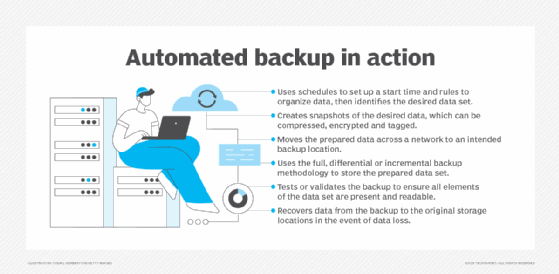Automated backup: How it works and why you should use it
Automated backup tackles complex data backups in concert with other automated workflows, minimizing human errors while ensuring regulatory compliance and business continuity.
Data is the lifeblood of any modern business involving customer contacts, business plans and communications, designs and trade secrets, and even real-time, real-world conditions from extensive fleets of IoT devices. That growing ocean of data is constantly accessed, organized, processed and analyzed, enabling businesses to make decisions, plan strategies, optimize operations and even train AI to create powerful new competitive capabilities.
But vast quantities of critical and connected data can also be an organization's greatest weakness. Data is constantly changing, storage resources such as disks can fail, application bugs and connectivity problems can corrupt vital data and disrupt time-sensitive analytics, and ever-increasing cyberattacks can destroy data, steal data or hold the organization's data for ransom.
The speed and risks of modern businesses place new emphasis on data protection. Even mundane tasks like backing up data have received a renewed focus that emphasizes the role of automation. Automated backup can tackle complex data backups in concert with other automated business workflows, while minimizing human errors and strengthening the company's compliance and business continuance posture.
What is an automated backup?
Automated backup is an IT process that links automation technologies to well-proven backup techniques used to copy important business data, applications and systems to selected storage resources using a predefined schedule.
Traditionally, backups were performed manually. Manual backups required human administrators to deliberately select the content to be protected, define the backup storage target and implement the backup process at a least disruptive time -- for example, overnight when business activity was slowest.
Manual backups were rife with potential problems. Administrators could easily forget to include important content, select unimportant content, choose an unsuitable storage target or miss an intended backup window. Human errors in manual backup processes could easily compromise data security, business continuity and regulatory compliance.
By integrating automation into the backup process, common human errors can be vastly reduced or eliminated entirely. A well-considered workflow can ensure automatic backup content is consistent, backup storage targets have the secure capacity required, data security measures are invoked and backups take place on a reliable schedule. This combination of factors can enhance business continuance and regulatory compliance efforts.
Benefits of automated backup for businesses
Automated backups can provide several important benefits for modern businesses, including the following:
- Data protection and recovery. Protection is the fundamental benefit of any backup schema -- protecting business data against hardware failures, human errors, natural and man-made disasters, and many types of cyberattacks. When a recovery (i.e., backup restoration) is required, administrators can restore content with the consistency and proper execution that automated backups can provide. Automation can typically assist with backup recovery, often providing fast, efficient and automatic restoration workflows when needed.
- Less human error. Automation can specify and remember all the common parameters involved in a backup process, including what is being protected, how it's being protected, how it's secured and where the backup target is located. Automation helps to ensure backups are executed properly and completely every time, regardless of the time of day or staff availability.
- Less human time. Automating the backup process frees human administrators from mundane backup tasks, enabling staff to focus on other priorities, handle other problems or work on more strategic projects.
- Better compliance. The ability to mitigate disruptions and continue normal business operations is a cornerstone of most business continuity and regulatory compliance obligations. Automated backups and recovery can help an organization meet those obligations by demonstrating its preparedness to protect and restore valued business systems.

Despite the benefits, however, automated backup can pose several concerns:
- Less flexibility. Automation can bring consistency to the backup process, but increasing automation will reduce the flexibility needed to quickly adapt to new or changing backup needs. Automation is best applied when workflows are well established and consistent.
- Objectives. Backups are always subject to recovery point objectives (RPOs) and recovery time objectives (RTOs). Designing the backup system and its supporting infrastructure must be considered carefully to meet these objectives, regardless of automation.
- Validation. An unusable backup is the same as no backup, so it's important to ensure that automated backup systems can test and validate every backup to ensure it's complete, intact and suitable for restoration.
- Networks. Modern backups rely on networks to exchange backup content with backup systems locally on a LAN or in the cloud across the internet. Network disruptions can impair backups by slowing the process or stopping it completely. Automation staff must ensure that networks are capable of backing up the required content in an acceptable time frame and can quickly address network issues.
- Complexity. Modern businesses can present a complex mix of operating systems, protocols and storage targets spread across physical and virtual servers that can be local, remote and in a cloud, making for extremely complex backup and restoration environments.
How does an automated backup system work?
An automated backup system creates scheduled copies of designated data without human intervention. There are two fundamental aspects of the system:
- Backup. Backups basically create copies of desired data to intended storage targets. Traditionally, those storage targets were tape or optical media, but today it's almost universally disk-based storage to local disks or storage resources in a cloud. Automated backups typically employ traditional backup methodologies, including full, incremental and differential.
- Automation. By adding automation technologies to backup tools, the backup process can be enhanced with the consistency of established schedules and extensive rules. Automation, for example, can ensure that desired backups are performed at regular intervals or in response to important events, such as system changes.

The overall process used to implement automated backups typically includes six distinct steps.
1. Organization
The automated backup process starts by using schedules to set up a desired start time and rules to organize data. The desired data set is identified and can involve systems, volumes, folders and individual files. Rules can also stipulate optional settings for use during the backup, such as whether to use compression or encryption.
2. Preparation
The desired data set is typically copied using a traditional volume shadow copy service or other tool suited to create snapshots of the data, so the data set can continue being used by production applications. At this point, the data can be compressed and encrypted, and suitable metadata (e.g., tags) can be applied as needed.
3. Transfer
Prepared data can then be moved across a network to an intended backup location. Networks are typically open LANs or internet networks using common network protocols such as HTTPS. The intended storage target can be a local disk on an existing backup server, network-attached storage (NAS) across a LAN or a storage resource in a cloud.
4. Execution
The prepared data set is then placed in the intended storage target using one of several traditional backup methodologies, including the following:
- Full backup. All designated data sets are copied to a backup storage device.
- Incremental backup. The only elements of a data set sent to the backup are the elements that have changed since the last full or incremental backup.
- Differential backup. The only elements of a data set sent to the backup are the elements that have changed since the last full backup.
5. Validation
Once complete, the backup is tested or validated to ensure all elements of the data set are present and readable from the backup storage target. If so, the backup can be deemed a success and an alert sent to administrators if required. If not, the automated backup can potentially retry copying any problematic data elements, retry the entire backup execution or generate an important alert indicating that the backup process wasn't successful.
6. Restoration
When a data loss event is recognized, the automated backup system can potentially invoke a restoration that recovers data from the backup to the original storage locations. The extent of the data set and the type of backup used, such as full versus incremental, will directly affect the recovery time.
How to set up automated backup
There are countless automated backup methods for personal use, small and medium-sized businesses (SMBs), small and medium-sized enterprises (SMEs), and full-sized enterprise environments. Consequently, there's no single setup for all automated backup needs, but there are several common considerations that can help ensure the most successful backup outcomes.
Select the backup tool
Perhaps the single most important element of any automated backup schema is the choice of backup tool. Android smartphone users, for example, might select Google One for automatic device backups, including calendar, contacts and app data. Windows users can use the built-in File History feature to back up files to an external drive or network location. Public clouds such as Google Cloud SQL or Azure SQL typically offer services for automated backups. Many varied third-party backup tools are well suited for complex enterprise use cases.
Configure the tool
Each tool will offer a variety of configurable options, including the following:
- Backup type: full, incremental or differential.
- Access control settings: authentication and authorization.
- Where to send each backup, such as a local disk, NAS or cloud service.
- Using compression to save storage space on the backup target.
- Using encryption to keep data secure at rest and in flight.
- Selecting the days and times to invoke the backup.
- Tags or other metadata to apply to each backup.
- Alerting and reporting options.
- How to respond to backup failures.
- Validating each backup.
Configuration options can typically be changed as needed, though changing a configuration might affect restoration actions. If a business changes from local server backups to cloud backups, for example, any backups on the local server can be easily forgotten or inaccessible for recovery.
Review the automation rules
Automation is typically driven by a script or set of discrete rules that dictate when, what, how and where to conduct each backup. The answers to these questions can change periodically. An organization, for example, might opt to switch from backing up data on a local NAS to a cloud storage resource. Consequently, it's important to revisit automation rules and configuration options, as well as address any relevant changes.
Practice restorations
Even the most well-considered backups are useless if they can't be restored efficiently and successfully. Activating a validation feature will help ensure each backup is successful, but it can be important to practice the restoration process periodically. Practice can reinforce the correct restoration process and -- more importantly -- reveal any gaps or problems that might interfere with recovery. It's better to find and address recovery problems before an actual restoration is needed.
How to choose the right automated backup method
There's no single approach to automated backups. The proper backup software or appliance approach will depend on a wide range of factors, such as the amount of backup, the available backup window (RPO and RTO), security needs, compliance obligations, staff skills and available budget. Some important factors to guide the best automated backup approach will include the following:
- Assess needs. Conduct a detailed inventory of data, applications and systems. Understand what needs to be protected and consider the amount and frequency of data that must be exchanged to ensure protection. Also factor in scalability and how that inventory is likely to grow in the years ahead.
- Determine objectives. An automated backup decision will hinge on the required recovery point and the recovery time. These choices will directly influence the backup type and supporting infrastructure and technologies for areas like storage capacity and network bandwidth.
- Evaluate security and compliance needs. Sensitive data protected by recognized regulations, such as HIPAA for medical data or GDPR for data in the EU, will demand security features like encryption and access controls. Choose backup methods that meet compliance obligations.
- Data backup types. Needs will drive the choice of backup type, such as full, incremental or differential. Select a backup methodology that can support the most appropriate backup type -- preferably several possible backup types.
- Choose a target or strategy. Consider the most appropriate backup target or strategy to accommodate business needs. A traditional 3-2-1 backup strategy -- 3 copies on 2 media, with 1 off-site -- might best address the broadest scope of potential incidents, but it could be reserved for the most critical or sensitive data. Other choices can include cloud backup targets, local backup targets or a hybrid blending of different strategies.
- Vendor support. Evaluate different backup product vendors and consider their costs, support options and reputation. Proof-of-concept projects can help businesses test and validate automated backup designs and performance before making a formal commitment to any one automated backup approach.
Stephen J. Bigelow, senior technology editor at Informa TechTarget, has more than 30 years of technical writing experience in the PC and technology industry.








